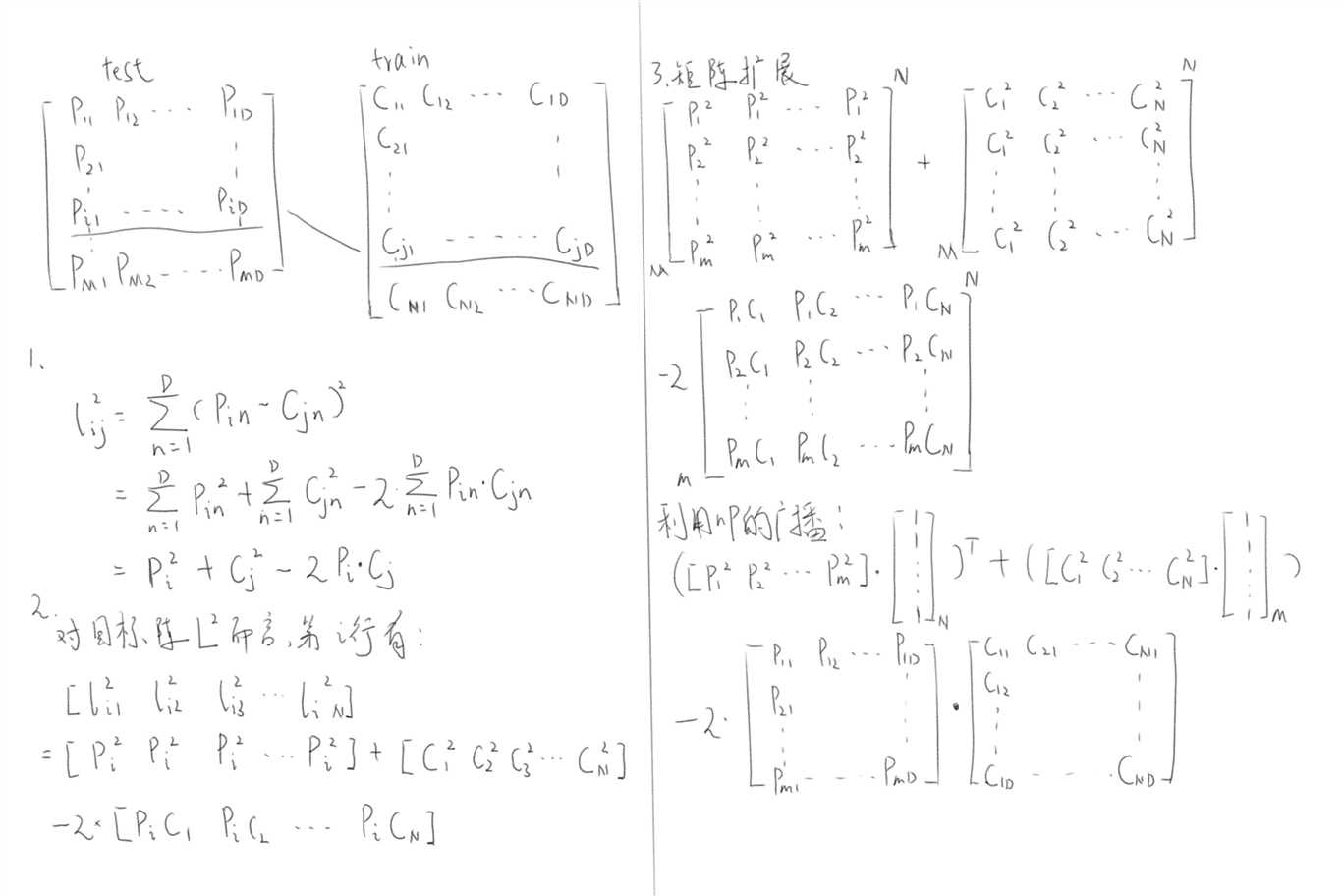标签:nat ice put with oat square cas cross training
茴香豆的“茴”字有... ...
使用三种计算图片距离的方式实现K近邻算法:
1.最为基础的双循环
2.利用numpy的broadca机制实现单循环
3.利用broadcast和矩阵的数学性质实现无循环
图片被拉伸为一维数组
X_train:(train_num, 一维数组)
X:(test_num, 一维数组)
import numpy as np a = np.array([[1,1,1],[2,2,2],[3,3,3]]) b = np.array([[4,4,4],[5,5,5],[6,6,6],[7,7,7]])
dists = np.zeros((3,4))
for i in range(3):
for j in range(4):
dists[i][j] = np.sqrt(np.sum(np.square(a[i] - b[j])))
print(dists)
[[ 5.19615242 6.92820323 8.66025404 10.39230485]
[ 3.46410162 5.19615242 6.92820323 8.66025404]
[ 1.73205081 3.46410162 5.19615242 6.92820323]]
dists=np.zeros((3,4))
for i in range(3):
dists[i] = np.sqrt(np.sum(np.square(a[i] - b),axis=1))
print(dists)
[[ 5.19615242 6.92820323 8.66025404 10.39230485]
[ 3.46410162 5.19615242 6.92820323 8.66025404]
[ 1.73205081 3.46410162 5.19615242 6.92820323]]
r1=(np.sum(np.square(a),axis=1)*(np.ones((b.shape[0],1)))).T r2=np.sum(np.square(b),axis=1)*(np.ones((a.shape[0],1))) r3=-2*np.dot(a,b.T) print(np.sqrt(r1+r2+r3))
[[ 5.19615242 6.92820323 8.66025404 10.39230485]
[ 3.46410162 5.19615242 6.92820323 8.66025404]
[ 1.73205081 3.46410162 5.19615242 6.92820323]]
无循环算法原理:
(注意,原理图-验证代码-实现程序 的变量并不严格一一对应,均有调整)

全代码实现如下:
import numpy as np
class KNearsNeighbor():
def _init_(self):
pass
def train(self, x, y):
self.X_train = x
self.y_train = y
# 选择使用几个循环体的方式来计算距离
def predict(self, X, k=1, num_loops=0):
if num_loops == 0:
dist = self.compute_distances_no_loops(X)
elif num_loops == 1:
dist = self.compute_distances_one_loops(X)
elif num_loops == 2:
dist = self.compute_distances_two_loops(X)
else:
raise ValueError(‘Invalid value %d‘ % num_loops)
return dist
def compute_distances_two_loops(self, X):
num_test = X.shape[0]
num_train = self.X_train.shape[0]
dists = np.zeros((num_test, num_train))
for i in range(num_test):
for j in range(num_train):
dists[i][j] = np.sqrt(np.sum(np.square(X[i] - self.X_train[j])))
return dists
def compute_distances_one_loops(self, X):
num_test = X.shape[0]
num_train = self.X_train.shape[0]
dists = np.zeros((num_test,num_train))
for i in range(num_test):
dists[i] = np.sqrt(np.sum(np.square(X[i] - self.X_train), axis=1))
return dists
def compute_distances_no_loops(self, X):
# num_test = X.shape[0]
# num_train = self.X_train.shape[0]
# dists = np.zeros((num_test,num_train))
dists = np.sqrt(-2*np.dot(X, self.X_train.T) +
np.sum(np.square(self.X_train), axis=1)*(np.ones((X.shape[0],1))) +
np.sum(np.square(X), axis=1)*(np.ones(X_train.shape[0],1)).T)
return dists
# 预测标签
def predict_labels(self, dists, k=1):
num_test = dists.shape[0]
y_pred = np.zeros(num_test)
for i in range(num_test):
closest_y = self.y_train[np.argsort(dists[i])[:k]] # 【【【按照距离给索引排序】取最近的k个索引】按照索引取训练标签】
y_pred[i] = np.argmax(np.bincount(closest_y)) # 投票,注意np.bincount()和np.argmax()在投票上的妙用
return y_pred
We have implemented(实施) the k-Nearest Neighbor classifier(分类) but we set the value k = 5 arbitrarily(武断地). We will now determine the best value of this hyperparameter with cross-validation(交叉验证).
import numpy as np
num_folds = 5
k_choices = [1, 3, 5, 8, 10, 12, 15, 20, 50, 100]
X_train_folds = []
y_train_folds = []
################################################################################
# TODO: #
# Split up the training data into folds. After splitting, X_train_folds and #
# y_train_folds should each be lists of length num_folds, where #
# y_train_folds[i] is the label vector for the points in X_train_folds[i]. #
# Hint: Look up the numpy array_split function. #
################################################################################
X_train_folds = np.split(X_train, num_folds)
y_train_folds = np.split(y_train, num_folds)
################################################################################
# END OF YOUR CODE #
################################################################################
# A dictionary holding the accuracies for different values of k that we find
# when running cross-validation. After running cross-validation,
# k_to_accuracies[k] should be a list of length num_folds giving the different
# accuracy values that we found when using that value of k.
k_to_accuracies = {}
################################################################################
# TODO: #
# Perform k-fold cross validation to find the best value of k. For each #
# possible value of k, run the k-nearest-neighbor algorithm num_folds times, #
# where in each case you use all but one of the folds as training data and the #
# last fold as a validation set. Store the accuracies for all fold and all #
# values of k in the k_to_accuracies dictionary. #
################################################################################
for k in k_choices:
k_to_accuracies[k]=np.zeros(num_folds)
for i in range(num_folds):
Xtr = np.concatenate(
(np.array(X_train_folds)[:i],np.array(X_train_folds)[(i+1):]),axis=0)
ytr = np.concatenate(
(np.array(y_train_folds)[:i],np.array(y_train_folds)[(i+1):]),axis=0)
Xte = np.array(X_train_folds)[i]
yte = np.array(y_train_folds)[i]
# [num_of_folds, num_in_flods, feature_of_x] -> [num_of_pictures, feature_of_x]
Xtr = np.reshape(Xtr, (X_train.shape[0] * 4 / 5, -1))
ytr = np.reshape(ytr, (y_train.shape[0] * 4 / 5, -1))
Xte = np.reshape(Xte, (X_train.shape[0] / 5, -1))
yte = np.reshape(yte, (y_train.shape[0] / 5, -1))
classifier.train(Xtr, ytr)
yte_pred = classifier.predict(Xte, k)
yte_pred = np.reshape(yte_pred, (yte_pred.shape[0], -1))
accuracy = np.sum(yte_pred == yte, dtype=float)/len(yte) # bool to int,我们需要显示指定为float
k_to_accuracies[k][i] = accuracy
################################################################################
# END OF YOUR CODE #
################################################################################
# Print out the computed accuracies
for k in sorted(k_to_accuracies):
for accuracy in k_to_accuracies[k]:
print ‘k = %d, accuracy = %f‘ % (k, accuracy)
『cs231n』作业1问题1选讲_通过代码理解K近邻算法&交叉验证选择超参数参数
标签:nat ice put with oat square cas cross training
原文地址:http://www.cnblogs.com/hellcat/p/7007103.html